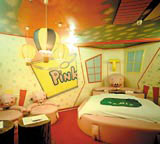Kitsch and tell
Dominic Lutyens takes a peek at the flamboyant, playful, but steadily diminishing love hotels of Japan, as documented by Kyoichi Tsuzuki

For 20 years, photographer Kyoichi Tsuzuki has recorded urban Japan’s Postmodernist, pick ‘n’ mix aesthetic – one that treads an ambiguous line between being seemingly knowing and kookily accidental. Like Martin Parr, Tsuzuki is drawn to banal, often seamy pop culture. He regards his photography as just as valid a form of social anthropology as any other. He has documented everything from poky Tokyo flats to fashion victims – the subject of his books, Tokyo Style and Happy Victims, respectively.
Aptly, for someone who documents ordinary architecture and street fashion, Tsuzuki often showcases his work via the democratic medium of books. He has created more than 30, including the book Roadside Japan, which comprises images of ‘ugly, unsung pockets’ of the Far East.
Japan’s love hotels are one pet subject, and 26 images of these are on show at East London’s Scout Gallery, in an exhibition called Satellite of Love: The Vanishing Beauty of Japanese Love Hotels. Some are predictable and clichéd. In one, a phallic, rocket-shaped bed implies that this spaceship-like love nest will take you to stratospheric heights of ecstasy. Other rooms, while clearly fetishistic, are bafflingly so. In one stands an ultra plastic four-poster bed and a Jeff Koons-eat-your-heart-out fairground horse. Another, its bedhead crowned by a cartoon piglet’s head and ceiling hung with hot air balloon-shaped lampshades, resembles a nursery.
The latter’s effect is nightmarish: is this a paedophile’s playpen? Or, with the word, ‘Pink’, writ large on one wall, a Pinky and Perky-style sex den for lovers turned on by helium-voiced squeals of passion? But many of the rooms have things in common – from a bizarrely infantile decor, which emphasises the hotels’ escapist appeal – to empty interiors, which, with not a humping punter in sight, give them a melancholy air.
Tsuzuki is considered part of a tradition of Japanese art that encompasses the voyeuristic photography of Noboyoshi Araki, for example, but, devoid of people, these images aren’t voyeuristic. They can be appreciated on various levels: as entertaining kitsch; as wacky interiors shots; and as environments tailor-made for specific sexual scenarios whose varying degrees of oddness – infantile or otherwise – beg for psychological analysis. But these images are also banal. Their contrived interiors – with their corny spinning beds, transparent baths and mirrored ceilings – presuppose they are titillating per se. But as ready-made environments, they rob sex of the one thing that makes it truly thrilling: spontaneity.
‘Love hotels’ is a sad misnomer. Lust hotels would be more accurate. Japan’s love hotels are well documented, and Tsuzuki would be saying nothing new if it weren’t for the fact that he has recorded a dying tradition. Usually located at expressway interchanges and railway stations – perfect for wham-bam encounters – Japan’s love hotels are in decline. Western-style, non-communal living is on the rise, reducing the need for them. Plus, new laws, designed to curb their perceived excesses, are subjecting them to rigorous hygiene checks and supervision. The title of this show brings to our attention that their days are numbered, uniquely adding a further layer of pathos to their forlorn tawdriness.
Kyoichi Tsuzuki, Satellite of Love: The Vanishing Beauty of Japanese Love Hotels is at Scout Gallery, 1-3 Munday Street, London N1, until 7 August
-
Post a comment




